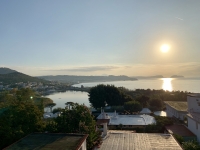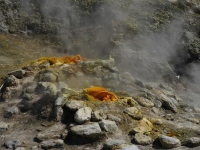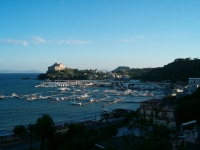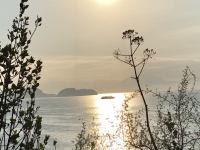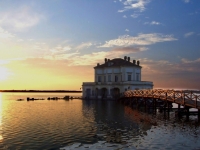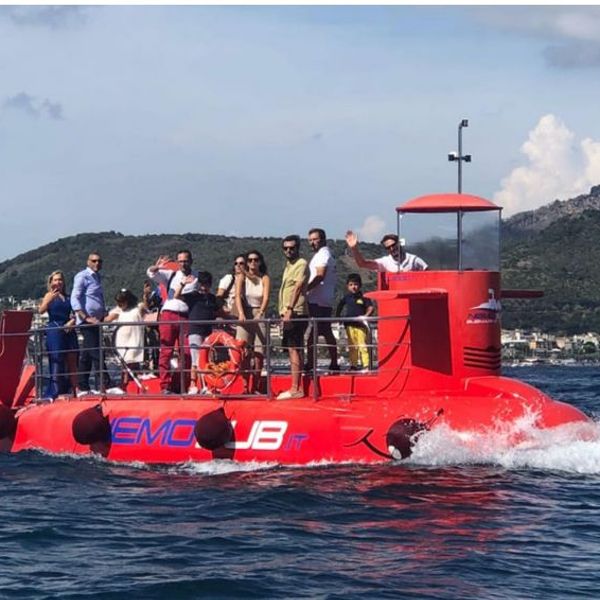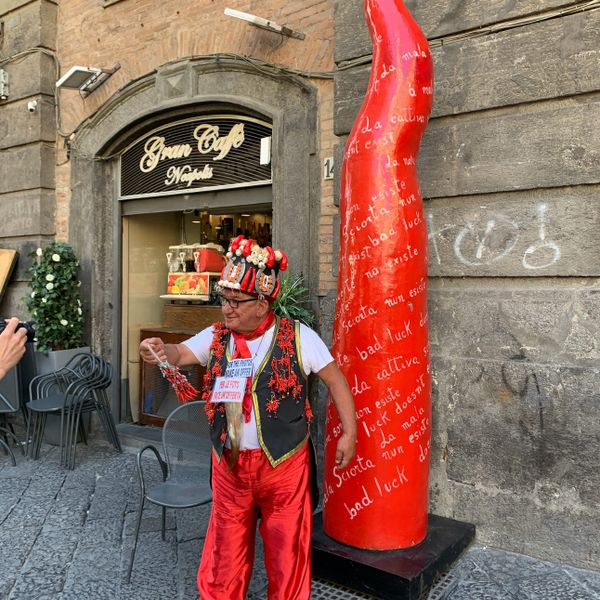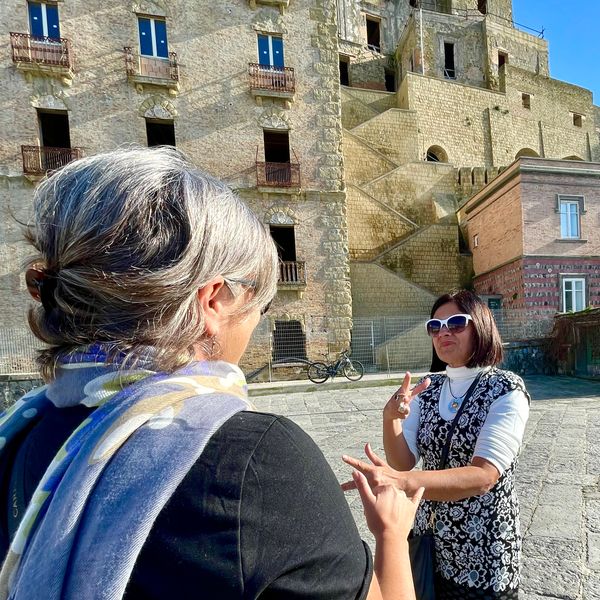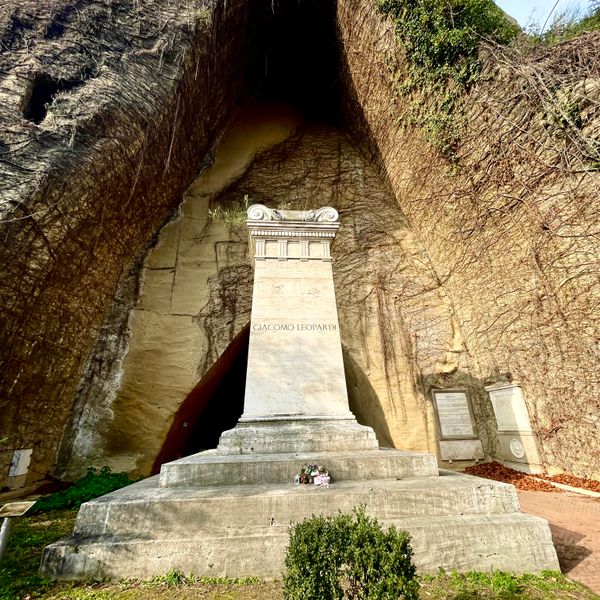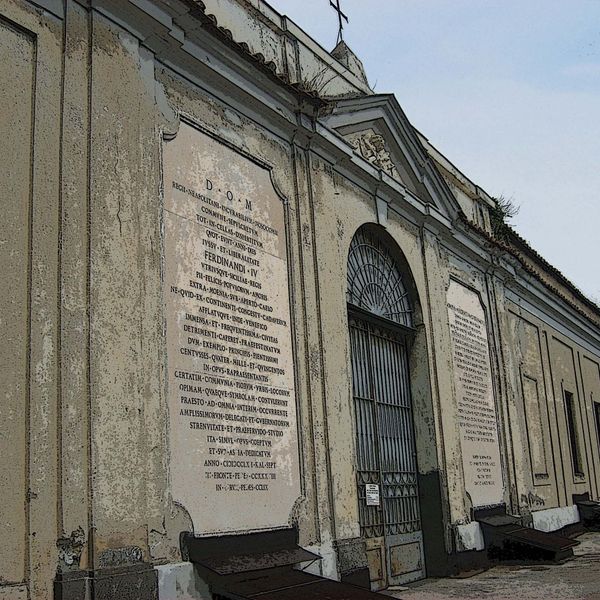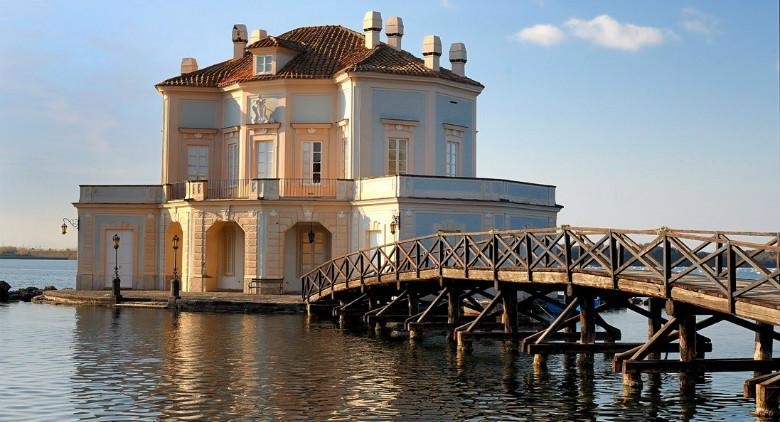
casina-vanvitelliana - foto meravosacampania.it
Beauty in the most dangerous volcano in the world
In the northern part of the Gulf of Naples, we find one of the coastlines, perhaps among the most beautiful in the world. A coastline that starts from Capo Posillipo to end at Capo Miseno, passing through Nisida, Bagnoli, Pozzuoli and all the Phlegraean fields including Arco Felice, Baia, Bacoli, Miseno and Monte di Procida. A wonderful area, inhabited, loved and praised by the ancient Greeks and Romans. Area with thriving nature and wonderful landscapes. A gulf that offers wonderful views where, on clear days, you can enjoy a view that starts from Vesuvius (with the entire Sorrento peninsula up to Capri) and reaches, on the other side, up to the islands of Procida and Ischia. Area where you can walk along the seafront and fall in love as the sun sets into the sea. Romantic area, rich in history and remains of Greeks, Romans, Byzantines up to the industrial archeology of the 20th century. An area absolutely suited to tourism, with many things to see and do, but above all where it is possible to eat excellent fish cuisine in a small restaurant directly on the sea. A place, therefore, of delight, but which also arouses fear and fear in residents as it is one of the most active and dangerous volcanic areas in the world. In fact, the Campi Flegrei area is a single large caldera in a state of quiescence, with a diameter of 12–15 km, in which there are numerous craters and small volcanic buildings (at least twenty-four), among which some present effusive gaseous manifestations (Solfatara area) or hydrothermal (in Agnano, Pozzuoli, Lucrino), as well as the cause of the phenomenon of bradyseism (very recognizable for its extent in the past in the so-called temple of Serapis in Pozzuoli). In the area there are lakes of volcanic origin (Lake Averno) and coastal lakes created by damming (Lake Lucrino, Lake Fusaro, and Lake Miseno).
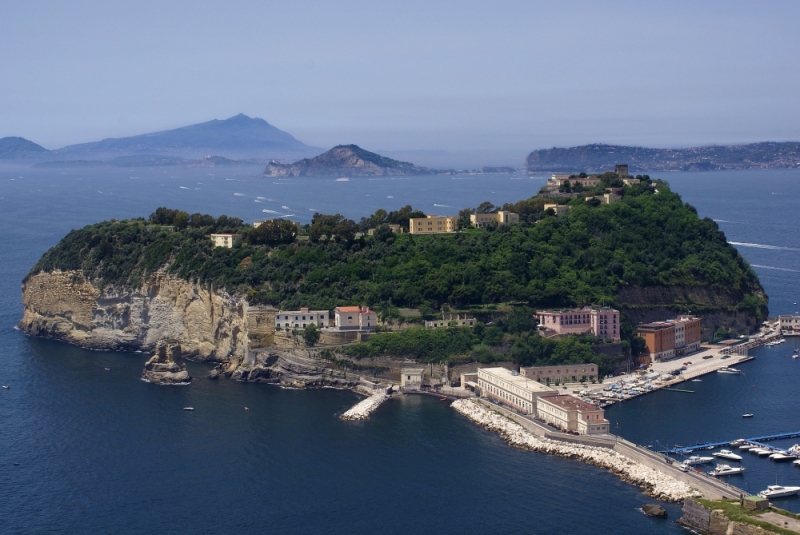
Nisida - Photo by Enzo Abramo from Pixabay
What see
1) Under Capo Posillipo there is
Nisida who, as stated in a famous song by the famous singer-author Edoardo Bennato, is "an island, but nobody knows". In fact it is an island of volcanic origin, which was connected to the mainland in the recent fascist era. Praised by Homer, who called it Nesis, it was the island where Ulysses landed with its ships (in the natural harbor of Porto Paone) and where he, in the cave of Seiano, blinded the Polyphemus Cyclops. In Roman times it was the seat of the villas of the nobles Lucio Licinio Lucullo and Marco Giunio Bruto. It was right here in Nisida that, in his villa, Brutus and Cassius, organized the conspiracy against Julius Caesar. Among the island's owners is Giovanni Piccolomini, who later became Duke of Amalfi, who had a castle built, planted vegetation and transformed Nisida into a place of attraction for nobles and artists. Being in a strategic position, in modern times Nisida was a watchtower and became an institution of punishment starting from 1800. Nisida still houses a Penitentiary for Minori (visited and also told by Benedetto Croce) and access, on the part high on the island, it is denied to the public. Traces of the ancient Roman port are still visible in the waters of Porto Paone.
Today, in the connecting part between the land and the island and, in what was once the port of Nato, the Neapolitans bathe in crystal clear water and enjoy an excellent aperitif at sunset, in the little cafes on the beach
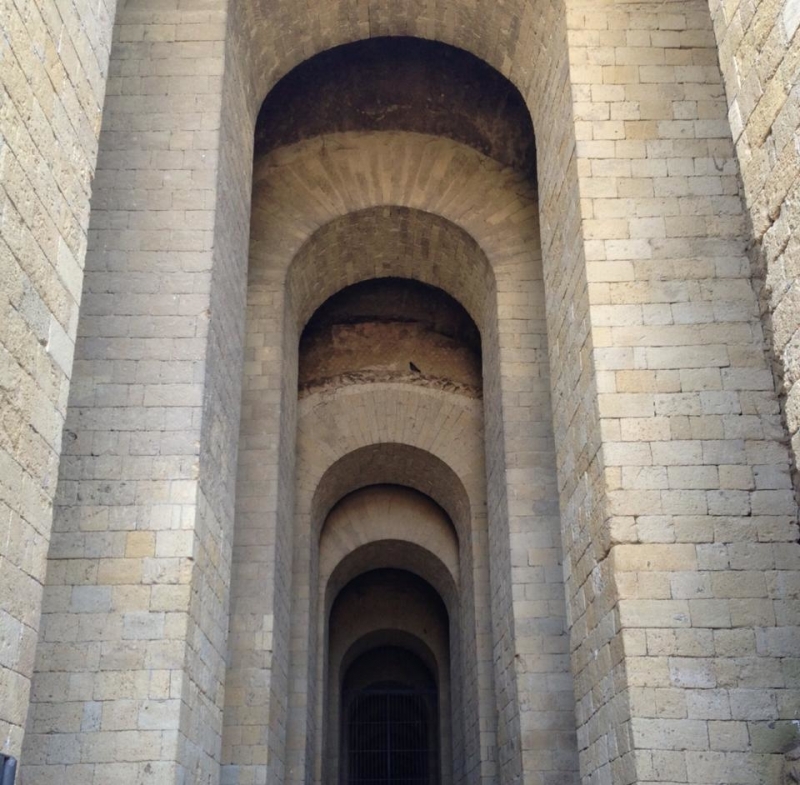
Seiano Cave - Posillipo Naples - Photo Roby Naples commons.wikimedia.org
Seiano cave
2) The cave of Seiano , was initially a natural cave that penetrated the hill of Posillipo for few tens of meters, which became, in the I century after Christ, a magnificent engineering work (still visitable today): a tunnel in the mountain 800 long meters, wide 5 and high 7. The Romans built it to connect the sea with the upper part of the hill, where the magnificent villa of the rich patrician Pollione was located. This work was so incredible that it was also narrated by authors such as Stazio, Plinio, Cicerone and Seneca. Ignored, it was found by chance in 1841 and made again viable thanks to the renovation work carried out by Ferdinand II of Bourbon. The cave is a tribute to the genius of the Romans, a must to visit and which still today amazes the tourist for its realization, thinking of the means available that were there at the time.
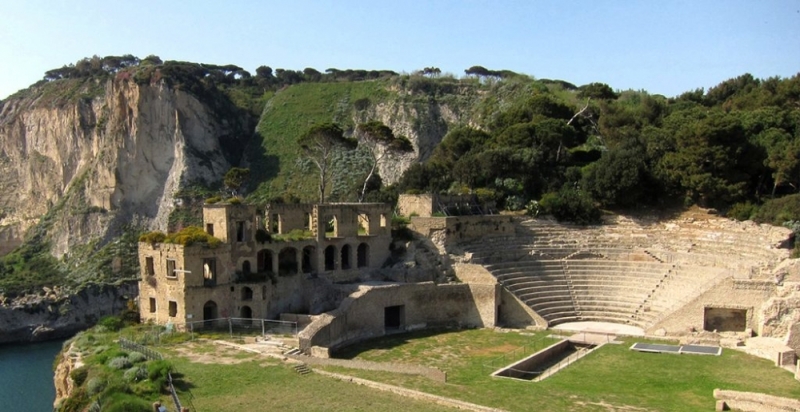
Naples Villa Pollione with Anfiteratro - Pausilypon Archaeological Park
Polijo town
3) Villa Pollione and adjoining Amphitheater : located on the top of the Posillipo hill, the villa is an integral part of the archaeological park of Pausylipon. The villa dates back to the 1st century BC and belonged to Publio Vedio Pollione, one of the richest patricians of the late Roman period. It was very large, extending from the promontory of Trentaremi to the reserve of Gaiola. It was also very famous, with interiors rich in mosaics, and was engineering at the forefront thanks to the pools and basins for the breeding of morays. The villa also hosted the Emperor Augustus, but the owner also lived, according to Cicero, with the reputation of a cruel and unfair man, intent on any vice. The Villa, with adjoining Amphitheater overlooking the sea, can be visited by appointment and with a guide.
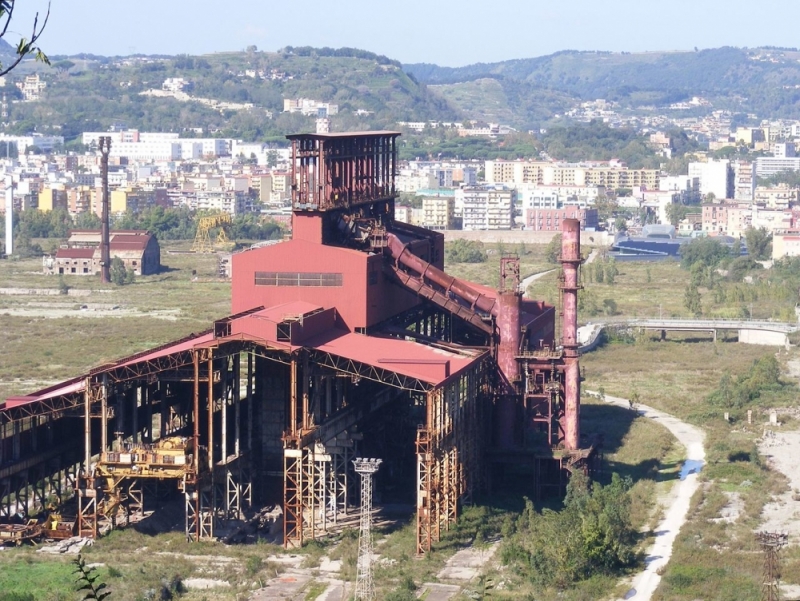
Napoli - Ex Italsider Bagnoli - by derelict_steelworks
Bagnoli
4) Bagnoli is a neighborhood in the western part of Naples, which owes its name to the Greek balneolis, as an area that housed several thermal places. Bagnoli, despite being part of one of the most beautiful coasts of Italy, has been for decades one of the most important industrial settlements of the south and, in particular, of the Ilva steelworks (ex Italsider) operating since the beginning of the 1900s and abandoned from the nineties. There are several places of interest including: Città della Scienza, the Museo del Mare, the Hippodrome of Agnano (the largest in Italy and where the GP Lottery, the Freccia GP of Europe and the GP Città are held every year of Naples), and the famous Terme di Agnano. The north wharf of the former Italsider, over 900 meters long and used once for loading and unloading materials, was restored and returned to the city in 2006, transformed into a pedestrian area. It is the longest promenade in Europe. Still in Bagnoli, it is possible to visit the Etruscan Archaeological Museum "DE FEIS" (Inside the Denza Institute) which exhibits finds and illustrations of the Etruscan people in Campania of the 6th century. to. C. and the sannitic one of the IV sec. BC In the hinterland of Bagnoli you can visit the WWF nature reserve in the Astroni Crater . The Reserve, located in the mouth of an extinct volcano, is a real green lung and rare plant species live there. Within the various paths, there are a forest and three ponds inhabited by numerous animals, especially birds. Treat yourself, especially at sunset, to a beautiful walk along the seafront, starting from Nisida, passing through bagnoli and ending with Pozzuoli. You will enjoy a view and an atmosphere that you can hardly forget.
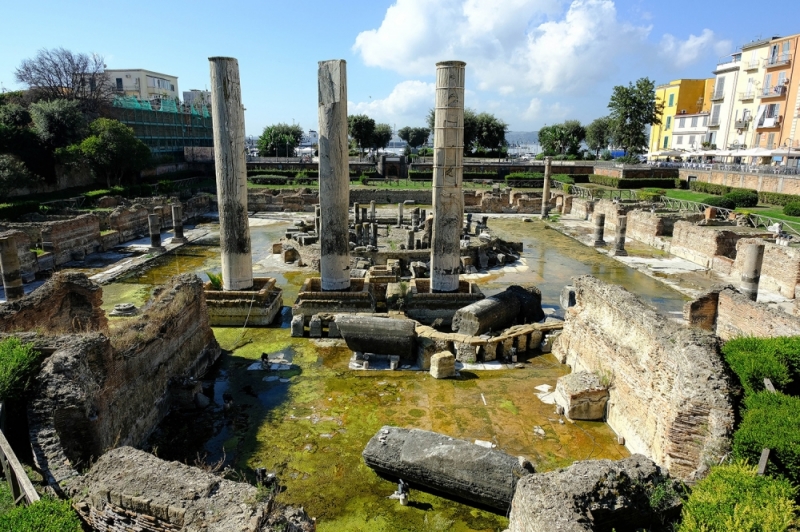
Temple of Serapis Pozzuoli
Pozzuoli
5) The first thing you will see when you arrive in Pozzuoli is what is called the " Temple of Serapis ", but in reality it is not a temple, but the "macellum", that is the ancient Puteolan market. The misunderstanding occurs because, during the excavations, a statue of the god Serapis was found. The Temple of Serapis, in spite of itself, is also the "thermometer" of the bradyseismic activity of Pozzuoli, which brings the temple, depending on the periods and the activity, to rise or fall with respect to sea level and, therefore, to to be invaded or not by several centimeters of water. To visit is the Sanctuary of San Gennaro (Patron Saint of Naples), where the stone on which the Saint was beheaded is still preserved Here, in the days of the feast of San Gennaro, while it takes place the miracle of the blood that liquefies in the ampules conserved in the Cathedral of Naples, this stone also acquires a livelier color due, also here, to the liquefaction of the drops of blood still present on the stone. San Paolo directly from Palestine) with its fishing boats, which will offer you freshly caught fish or a walk in the Roman remains of Villa Avellino, to see is the oasis of Monte Nuovo (a mountain that was formed in only 48 hours) and during a disastrous eruption in 1538). A special mention, finally, goes to the Rione Terra which, inhabited as early as the 2nd century BC, was completely abandoned in 1980 due to bradyseism, which is being reborn thanks to a work of redevelopment.

Flavian Amphitheater - Pozzuoli
6) The Flavian Amphitheater : in a ranking of the largest amphitheaters built by the ancient Romans, the Flavian Amphitheater is the third. Completed in 79 AD the amphitheater is the same as the Colosseum in Rome, only smaller. Built to accommodate 30,000-40,000 spectators on three levels, it could host shows with gladiators, ferocious animals, but also (thanks to its connection to the aqueduct), incredible shows and re-evocations of naval battles. The Emperor, during his holidays in these areas, attended the shows. The amphitheater also hosted the death sentences of the first Christian martyrs, including that of Santo Gennaro (patron saint of the city of Naples) who, according to legend, was condemned to be torn to pieces, but the ferocious beasts, instead of tearing it to pieces, knelt down at his feet. In fact he died months later in the "solfatara" due to a second sentence. Of particular value and, absolutely to visit, are the perfectly preserved underground (better than those of the Colosseum) where it is still possible to see machines, pulleys and elevators used to bring people and animals into the arena.
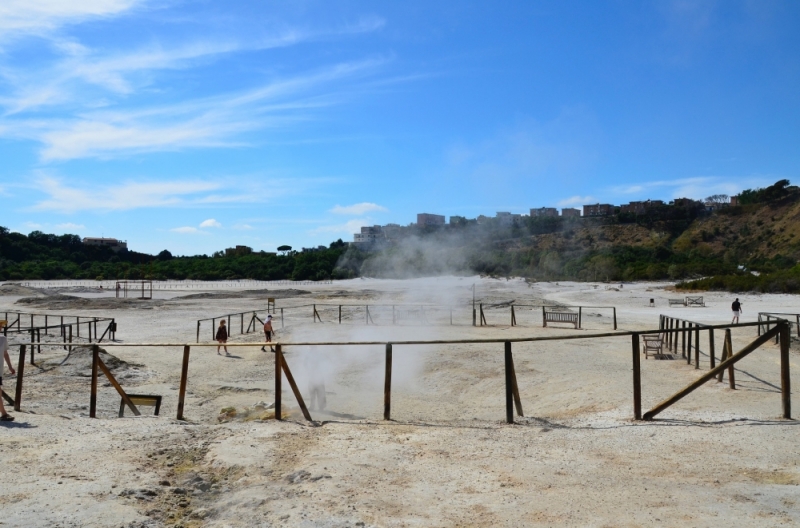
pozzuoli solfatara - Photos by valentina Ficuciello by Pixabay
Flavio Amphitheater
7) The Solfatara Volcano , among numerous fumaroles and boiling mud pools, is one of the active volcanoes in the Campi Flegrei area. Also destination of the so-called "Grand Tour" (educational journey for the young of the noble European families) was, around 1900, a thermal establishment, in which it was possible to be cured with mud and sulphurous waters, as well as to bathe in steam in the so-called stoves Today is one of the most monitored volcanoes in the world because it is considered extremely dangerous for the entire balance of the Earth.
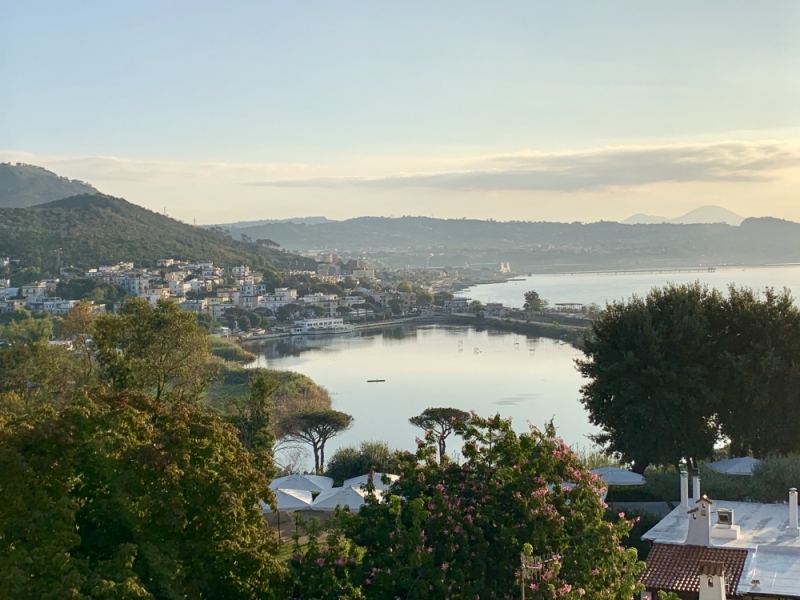
View of Lake Lucrino and Pozzuoli
Ancient Submerged City of Baia
8) The only example in the world of the "submarine" Museum is the archaeological park of the Ancient Submerged City of Baia . The city, sunk slowly over the centuries due to bradyseism, can be visited, today, only with masks, fins and tanks (... and authorized guide !!). Baia was a place of vacation of the Roman patricians and emperors since the late Republican age and up to the Empire of Augustus, today it is renowned for the quality of its sulphurous waters (excellent for solving health problems), but above all for the crystal clear waters of the sea and for places of enchanting nature. Prominent personalities such as Cicero, Nerone and Caesar probably visited these baths and, as many prestigious figures of the Rome of those times, possessed beautiful villas there in Baia. Today, in this unusual underwater visit, it is possible to admire the remains of temples, beautiful mosaics and villas, adorned with statues. Here in Baia, Nero had an Ebeterion built in his Baia Palatium, a place of entertainment reserved for the officers and sailors of the naval fleet located in Lake Miseno.
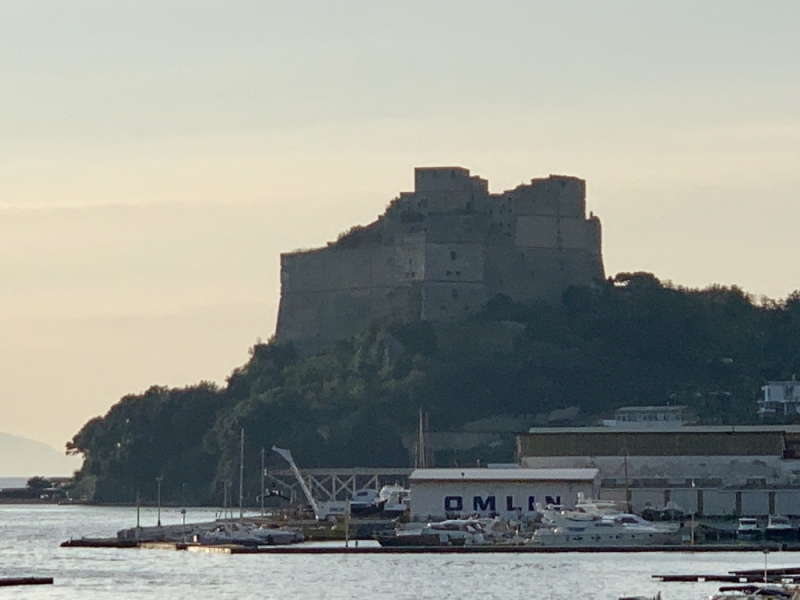
Archaeological Museum of Baia
Baia Museum
9) The Archaeological Museum of Baia has been set up in the Aragonese Fortress Castle which, in five sections, proposes the history of the ancient sites present in the Phlegraean Fields: Cuma, Puteoli, Baiae, Misenum and Liternum. Findings representing sculptures, inscriptions, architectural coroplasty, figured terracottas, pottery, metal and glass artifacts, jewelery and coins, tell the story and the wealth of the villas and settlements before the Greeks (between the 8th and 5th centuries BC), then of the Samnites (4th century BC), of the Romans and finally of the Byzantines in these areas. The beauty of the preserved works, together with the reconstruction of the rooms of some rich villas, the breathtaking view enjoyed from the castle terraces, absolutely deserve the cost of the ticket.
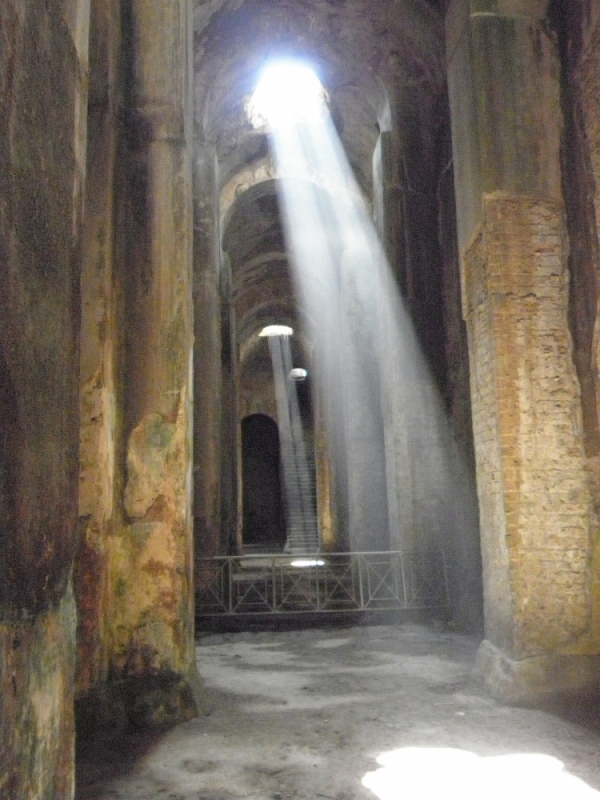
Bacoli - Mirabilis pool - photo by RaBoe
The swimming pool is wonderful
10) Bacoli, with its huge cistern called " Piscina Mirabilis ", is the point of arrival of the incredible engineering work that is the Augusteo Aqueduct (96 km long and starting from Monte Serino - Avellino). The Piscina Mirabilis, built in white tuff, with its 15 meters high and 25.5x70 wide, guaranteed a reserve of drinking water, equal to 12,600 cubic meters, to the imperial military fleet during the Roman era. Entirely carved in white tuff, the interiors are divided into 5 naves, 13 courtyards and 4 rows of pillars that support the vault. It was a regular stop on the Grand Tour (a sort of journey of initiation of the rich young men of the European aristocracy starting from the seventeenth century with the aim of perfecting their knowledge) which also led to the likes of Dumas, Goethe and Mozart to visit it . The Acropolis of Cuma, tells us how was the Hellenic colony of Magna Graecia, among the oldest and most distant from the motherland. Founded around 720 - 740 BC, Cuma was one of the colonies that spread Greek culture in Italy, spreading the Calcidese alphabet, which was later used by the Etruscans and Latins. Intimately linked to Cuma, it is the myth of the Sibilla Cumana (still a tourist attraction of considerable interest, as it is considered the Antro della Sibilla Cumana). The colony was fervent and powerful until 421 BC, when it had to succumb to the advance of the Campanians. Tarquinio the Superb, the last king of Rome, lived the last years of his life here, in exile after the establishment of the Roman Republic.
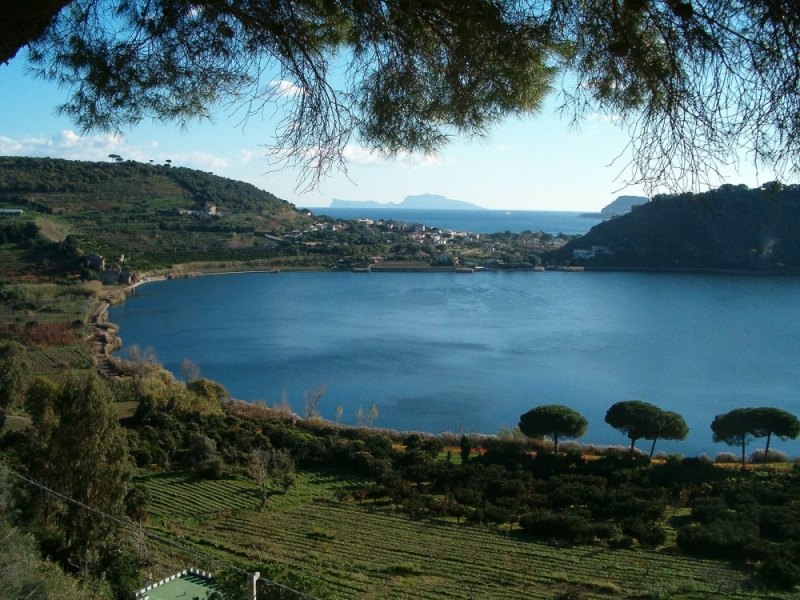
Lake Averno and Monte Nuovo - photo by Denghiù it.wikipedia.org
Tour of the 4 Lakes of Volcanic origin
11) An interesting tour, from a naturalistic, historical and geological point of view, is certainly the Tour of the 4 Lakes of Volcanic origin: Averno Lake, Lucrino Lake, Miseno Lake and Fusaro Lake . The lake of Averno is the lake where, according to Virgilio in the Aeneid, Charon ferried the souls towards the door of the underworld. It covers an area of 55 hectares, perimeter 2.86 kilometers, maximum depth 34 meters. This is a typical example of a lake crater, which owes its name and legend, probably to the fact that in the past there were exhalations of hydrogen sulfide or carbonic acid so intense that life was impossible for any animal , to the point of making it a "hell". Lake Lucrino is a brackish body of water, separated from the sea by a thin strip of land, and extends just under 10 hectares. From the Latin lucrum, it is celebrated by Orazio for the "lupus" bass and the oysters raised here by the Romans, but also by Marziale and Giovenale, in whose writings they told of the cheerful and carefree life of the Roman patricians, which took place in the luxurious villas around at the lake. With Vipsanio Agrippa, at the beginning of the imperial era, the Lucrino lagoon constituted the external basin of Portus Julius and was connected, by means of canals, on one side with the inner basin of Averno, where the ships were set up and repaired of the military fleet and, on the other, with the external sea of the Gulf of Pozzuoli. Lago Miseno is a shallow coastal lagoon, which through a short mouth is in communication with the port of Miseno, with which it occupies the bottom of a volcanic crater. Starting from 12 BC, until the fall of the Western Roman Empire, it was the base of the Roman military fleet and had the task of keeping the entire western Mediterranean under control. Among the admirals of the naval army misenate are Pliny the Elder (who died suffocated by poisonous fumes in the attempt to rescue the populations struck by the eruption of Vesuvius in 79 AD) and Aniceto (who, by order of Nero, had the mother of the emperor Agrippina Minor). Lake Fusaro , with its 101 hectares of extension, a maximum depth of about 8 meters and 4 kilometers perimeter, is separated from the sea by a sand dune, to which it is connected by 3 foci. It was once a hunting reserve of the King of the Two Sicilies, Ferdinand IV of Bourbon and housed a forest of oaks and pines. The remains of the ancient prefect of the Roman praetorian Servilius Valius and the canal built by the Romans are still visible today, described already by Seneca. Fusaro has always been considered particularly suitable for mussel farming (especially mussels, but also oysters). On a small island, joined to the shores of the lake by a wooden bridge, is the Bourbon hunting lodge, called Casina Vanvitelliana, named after the architect Luigi Vanvitelli and wanted by Ferdinand IV of Bourbon. With a Baroque style facade it was chosen as the location for many films.
For those in the area, don't miss the sunset seen from the viewpoint of Capo Miseno, from which you can enjoy a splendid view of the islands of Procida and Ischia, including the bay of pozzuoli and Bagnoli, up to Nisida and Capri.
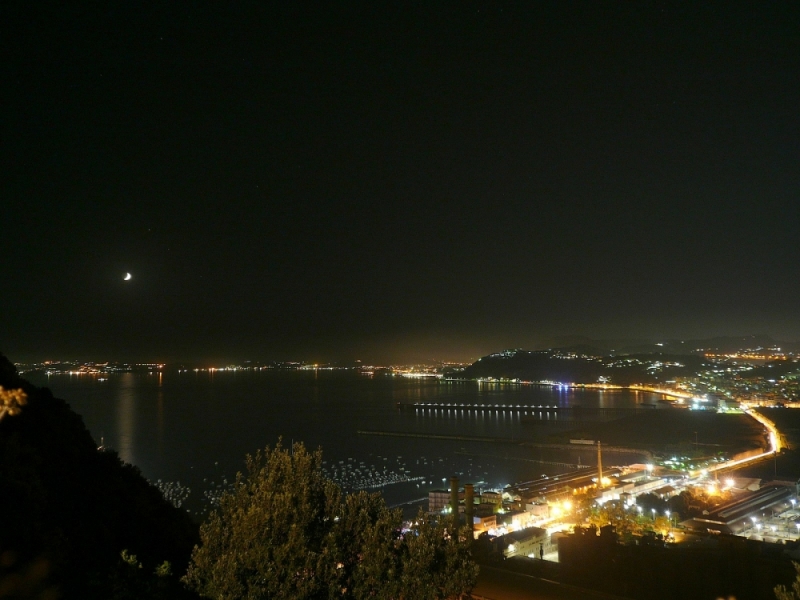
Gulf of Pozzuoli
Movida and Entertainment
Bagnoli: In Bagnoli it is possible to have fun passing a few hours to the shooting range, or taking a tan by the sea, on one of the shores of this area (Bagno Fortuna is among the oldest and most popular). Over the weekend, Bagnoli is an established destination for the nightlife of the city of Naples, it is possible to hunt for fun among the discos on the beach and the many pubs that overlook the waterfront, up to Pozzuoli. There are numerous "cornetterie", open all night, where you can enjoy an excellent croissant or a freshly baked "sfogliatella". Along via Napoli (between Bagnoli and Pozzuoli) you will be spoiled for choice among the many typical restaurants, directly on the sea, which offer typical cuisine (especially fish) and excellent pizzas. If you love outdoor sports, you can go jogging on this beautiful promenade (recently restored) or a basketball game with friends, in the public gardens of Via Napoli Pozzuoli side. The former headquarters, instead, of the Italsider factories was used for the first editions of the Neapolis Festival, where the concerts of artists such as REM, Jethro Tull, The Cure, Patti Smith, Peter Gabriel and many others have followed others.
City of Science, the first Italian interactive scientific museum, instead, continuously hosts fairs, exhibitions and cultural activities. Here, children and others, in an interactive way, will be able to experiment and learn, in an interactive way, the principles of science and technology. For body care enthusiasts, a day at the
Agnano Spa and Spa is mandatory
. In function since the times of the Romans, they exploit the warm and sulphurous waters of volcanic nature present in the strata of this area and are a true park of health and well-being. Here you can take thermal cures, inhalations, nebulisations, stoves, hydromassages and you can take advantage of the thermal water pools, mud baths, massages, etc.
Pozzuoli: a gathering in the weekend of many young people, both Neapolitans and not, is very rich in clubs, pubs, disco bars and excellent restaurants where you can enjoy an aperitif, a beer or a great dinner based on fish and local delicacies . If you are passionate about the sea, in the port of Pozzuoli, but also in Baia and Miseno, you can rent a boat (sailing or motor) to explore the beautiful coasts of this area. If you are also a lover of scuba diving from Baia, with well-equipped diving and expert guides, you can make unforgettable dives on different sites, including the upper part of the ancient Bay with statues and beautiful mosaics from the Roman era. For wellness lovers, we recommend the " Stufe di Nerone", located in Lucrino, where it is possible to sauna in natural caves or spa treatments, spas, massages, and more, but also where you can simply relax, take the sun on a cot. Pozzuoli is also beautiful for going for a walk, tasting a good artisan ice cream or, simply, enjoying a bit of coolness on summer evenings. Among the places to be reported: the Naïf, in the suggestive location of Nisida, is the right place, super panoramic, where you can enjoy an aperitif at sunset, prepared with real mastery and theme parties, DJ sets and live music. The Neasy , in an exclusive setting, it is the reference point of the Neapolitan nightlife, ideal for a demanding and fashionable clientele. For a fun-filled weekend, the Partenopeo Club is the right place. With quality music and guests from all over the world, it's definitely a place to visit. Saloon La Veronica is a real living room that is a beach bar during the day, while in the evening it turns into a lounge bar with music, aperitifs and cocktails. The Singha, overlooking the Posillipo hill and the Phlegraean fields, is a place halfway between a lounge bar and a disco. On Saturdays here, in an atmosphere of soft lighting, we organize some of the coolest summer evenings.
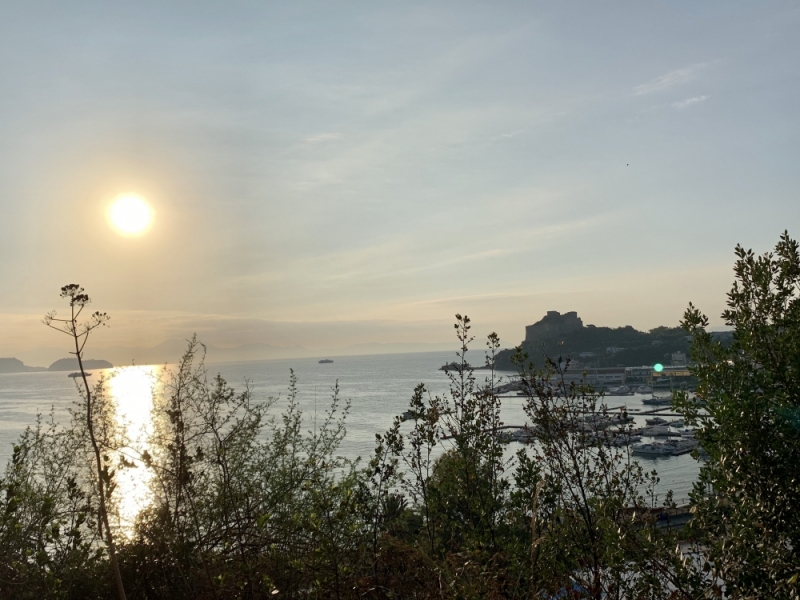
View of the Bay and the Castle
Climate, Curiosities and Advice
Climate: The climate in this area is Mediterranean, with mild, rainy winters and hot, dry summers, up to 35-40 ° C. The rains are mainly in spring and autumn, in the months of March, April and October, November. Snow and frost are very rare. This is a city to visit 12 months a year, because even in the coldest periods, there is always a bit of sun that heats up. However, the best times are May, June, September and October as they are warm but not sultry months as instead are July and August. In summer you can enjoy pleasantly warm sea waters and well-equipped beaches.
Curiosity : few know that in Pozzuoli, after a long and perilous journey, the Holy Apostle Paul, from Palestine, landed in 61 AD. It was hosted for a week by friends of the Christian community who were then one of the first and most ardent. To witness this landing there is even the book of the Acts of the Apostles: "The following day the sirocco rose and so the next day we arrived in Pozzuoli. Here we found some brothers, who invited us to stay with them for a week. to Rome "- Acts of the Apostles 28, 13-14. The quay at Pozzuoli was crowded with onlookers and time-wasters: thus Seneca described it to Lucillo. On the quay of the port of Pozzuoli, on the external part of the apse, of the Church of Santa Maria delle Grazie, two tombstones can be admired: one, from 1918, which recalls the landing of Paolo di Tarso in Puteoli, with the symbols of the apostle , and the other in memory of the visit of Pope John Paul II on November 12, 1990. Between the two epigraphs stands the majolica of Giuseppe La Mura, depicting the arrival of Saint Paul on the Puteolano pier, inaugurated on June 29, 1991.
Advice: The advice is to be curious, to walk around this area without fear, visiting it all. Here people are extremely sociable and helpful and it is not uncommon that, if you ask for an indication, they will accompany you directly. Sit in a bar along the sea or at the port of Pozzuoli, enjoying the warmth of the sun and the view of the sea. Enjoy an excellent Neapolitan coffee (restricted and strong), an artisan ice cream or a pastry like sfogliatella or babbà, and you will see that life will smile at you. The autochthonous vine of this area is the Falanghina dei Campi Flegrei (a white wine), which owes its minerology and flavors to the volcanic soil on which it grows. As soon as you have the opportunity, drink a glass, rigorously cold, and you will have an explosion of sensations that you will not forget, better if you accompany it to a fish-based dinner.
How to get around: If you want to visit this area in its entirety, the advice is to do it with your own car or to rent one, as there are many distances and public services, here, are not the best that Naples offers. If instead you want to visit only Bagnoli or Pozzuoli, you can reach it with the "Cumana" train from the "Pigna Secca" station (central Naples) or if you want to visit Pozzuoli only, you can also do it with the Metro 2 from the central station of Piazza Garibaldi . Alternatively there are always taxis.
















